Cholesterol is one of many factors that impact your risk of heart disease. Cholesterol itself is not the enemy, but when the types of cholesterol and the particles carrying them around are out of balance, it’s time to make some adjustments to decrease your risk.
Think about the big picture to support your cardiovascular health and #cholesterol. #hearthealtth #saslife Click To TweetCholesterol forms vitamin D, bile acids and steroid hormones (e.g., testosterone, estrogen, progesterone, cortisol), and it stabilizes every cell membrane in our bodies. We need adequate cholesterol levels to feel good, to digest our food properly and to have a strong immune system.
Our liver produces most of the cholesterol we need, but we also absorb some from food. In an ideal world, the amount that we make and absorb would be just the right amount without too much left over. In reality, chemical signals from many factors (the foods we eat, genetics, body fat around the midsection, exercise and even the composition of our gut microbiome) can shift our cholesterol in a favorable or unfavorable direction.
To get to where it is needed in the body, particles called lipoproteins transport cholesterol through the blood stream. Lipoproteins are like cars that carry cholesterol and fats around the body, and the cholesterol and fats are like passengers in the car.
There are different versions of these lipoproteins, and they vary according to their size and their make-up. Look here for more details about triglycerides (fats) and types of lipoproteins. The number and size of cars on the road (lipoprotein particles) seems to be a better indicator of heart disease risk rather than just looking at the total number of passengers in each car (concentration of cholesterol inside the lipoproteins).
Small, dense LDL cholesterol and small, dense LDL lipoproteins show a positive correlation with coronary heart disease. This is because these particles are likely to become damaged (from oxidization, glycation, etc.), and because they are small, they’re more likely to penetrate the artery wall. Both of these factors contribute to the buildup of plaque on the artery walls.
Tips to Improve Your Cholesterol
Many factors can affect quality and quantity of your lipoprotein particles and cholesterol. Genetics and age have some impact, however a study published in the NE Journal of Medicine in 2016 confirmed that even those at high genetic risk can cut their risk for cardiovascular disease in half with lifestyle changes.
Though the old recommendations around cholesterol primarily focused on restricting foods high in cholesterol, newer guidance from the American Heart Association emphasizes the promotion of healthy dietary patterns overall. To optimize cholesterol levels and to decrease the risk of damaging LDL cholesterol, aim for a high-quality anti-inflammatory eating pattern, limiting packaged and processed foods and consuming mostly real, whole foods. Here’s how:
1. Reduce or eliminate refined carbohydrates and excess sugar.
Sugar, white flour, white rice, other processed grains and foods made from those items (e.g., white bread, pasta, crackers, cereal, pretzels) can increase triglycerides and the dangerous kinds of LDL cholesterol and reduce the beneficial HDL cholesterol. Read ingredients to determine if foods are high in refined carbs or sugar. If you drink sweetened beverages, consider swapping them out for unsweetened green tea which has anti-inflammatory effects and been shown to reduce LDL cholesterol.
2. Portion ¼ of your plate or less with whole intact grains, starchy vegetables or fruit.
Intact grains like steel cut oats, wheat berries, quinoa, millet or brown rice provide more fiber and nutrients than their processed counterparts. Nutrient dense carbohydrates like sweet potatoes, butternut squash and whole fruits are also a great source of nutrients and fiber.
3. Fill ½ of your plate with non-starchy vegetables.
Loaded with powerful antioxidants (to help prevent excess oxidation), nutrients and fiber, all non-starchy vegetables help improve cholesterol and heart health in many ways. Aim for a colorful variety of non-starchy vegetables daily.
4. Be finicky about fats.
Include healthy unsaturated fats at each meal. Raw nuts and seeds (especially walnuts and almonds), avocados, olives and extra virgin olive oil are helpful in keeping our cholesterol healthy.
Eat 2-3 servings of fatty fish per week. Fish like salmon and sardines are rich in potent anti-inflammatory omega-3 fats which have been shown in some studies to decrease LDL particle number, increase particle size (to the less dangerous large fluffy LDL particles), increase HDL and decrease triglycerides. Supplemental omega-3s may be beneficial if you don’t eat fish, but talk to a Registered Dietitian Nutritionist or other health care provider before choosing a fish oil supplement because quality varies dramatically from product to product.
Avoid industrially processed fats and oils, and moderate intake of saturated fat – Industrial oils extracted from soybeans, corn, rapeseed (source of canola oil), cottonseed and safflower seeds are easily oxidized (damaged) during processing and are high in omega-6 fatty acids, both of which contribute to pro-inflammatory conditions in your body. Trans fats, which lower HDL and increase the dangerous forms of LDL, have been banned in many countries. As manufacturers have removed trans fats from their products (e.g., cookies, biscuits, margarine, non-dairy creamers, fast food) many have replaced them with highly processed saturated fats that should be avoided.
Some saturated fats have certain health benefits but can be easily overdone and can impact total LDL cholesterol levels. When using saturated fat in cooking, stick with small portions of organic virgin coconut oil, grass-fed butter or grass-fed ghee.
5. Include quality protein at each meal.
Protein should be your stable foundation for every meal. Choose skinless lean cuts of meat, pasture-raised/grass-fed meats and dairy products, or plant-based proteins (e.g., tempeh, tofu, lentils and beans) to provide the nutrients your body needs while limiting excessive amounts of saturated fats. Cholesterol-optimizing standout: soybeans (e.g., edamame and tempeh).
Click here for more details about how to manage your cholesterol naturally and which foods can optimize your cholesterol levels.
If you are unsure where to start, seek personalized guidance. There is a wide degree of individual responses to standard dietary recommendations, and working with a Registered Dietitian Nutritionist can help you find a plan that works best for you.
Diet isn’t the only thing that can impact your cholesterol and heart health. Including daily movement, addressing stress and working on getting quality sleep are all important. Chronic inflammation, poor thyroid function, stress overload, insulin resistance, certain medications and other health issues can impact your cholesterol too. Regular checkups with your health care provider can help you stay on top of your health.
Chickpea Scramble Breakfast Bowl
Makes 2 servings
Recipe adapted from: Well and Fed
PRINT RECIPE
Ingredients
CHICKPEA SCRAMBLE
1 15 oz can of chickpeas or 1 ½ cups drained
cooked chickpeas
½ tsp turmeric
½ tsp salt
½ tsp pepper
¼ white onion
2 cloves garlic
drizzle of extra virgin olive oil
BREAKFAST BOWL
mixed greens
handful of parsley
handful of cilantro
1 small avocado
Directions
FOR CHICKPEA SCRAMBLE
- Pour chickpeas and a little bit of the water they’re in into a bowl. (Plain water will also work if not using canned chickpeas.)
- Mash chickpeas slightly with a fork, leaving some whole.
- Mix in turmeric, salt and pepper until evenly combined.
- Mince garlic and dice onion.
- Heat a pan over medium heat with a drizzle of olive oil.
- Sauté onions until they are soft, 3-5 minutes.
- Add garlic and continue sautéing until garlic is fragrant, about a minute or so. Be careful not to let the garlic brown.
- When onions and garlic are done, add in mashed chickpeas and sauté for about 5 minutes.
FOR BREAKFAST BOWL
- Chop parsley and cilantro and slice or chop avocado.
- Add some mixed greens to 2 bowls.
- Divide chickpea scramble into the bowls on top of greens.
- Top with avocado, parsley and cilantro.
NOTES
- This recipe is turmeric-forward. If turmeric is not your thing, feel free to use less or omit altogether.

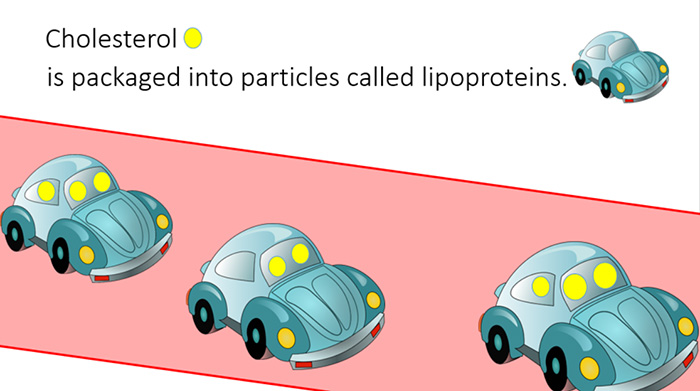
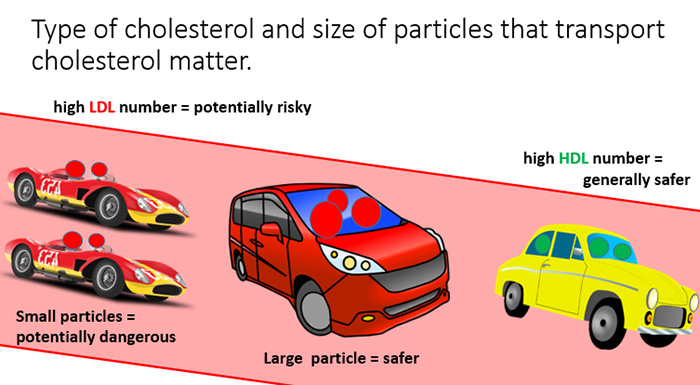
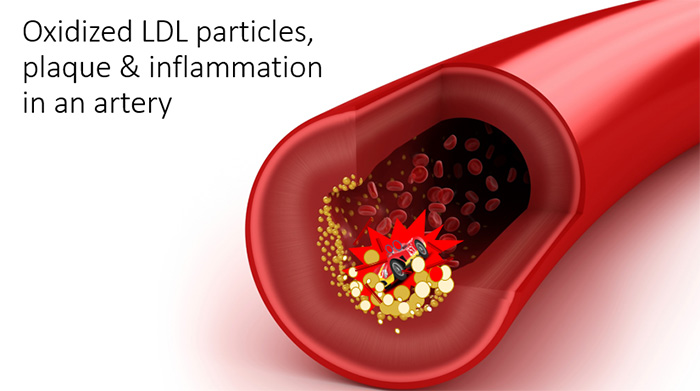
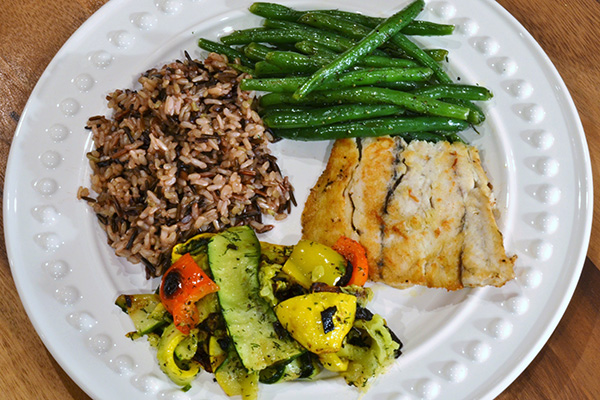
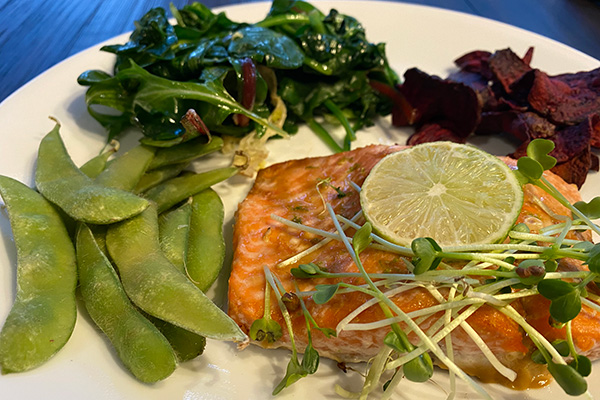

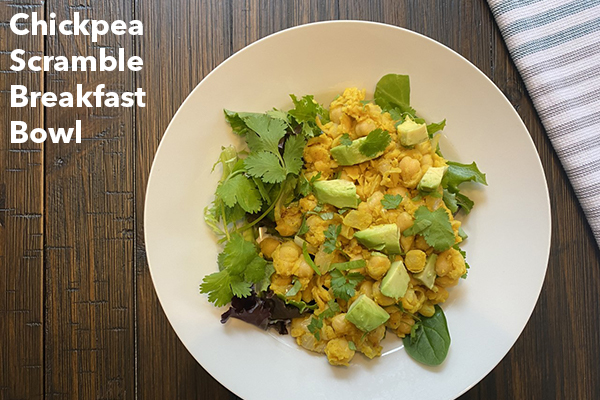
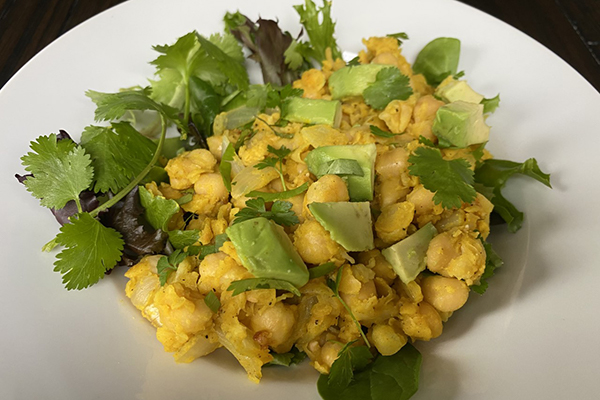

2 Comments
Recipe looks delicious. Good, straightforward tips for individuals making initial lifestyle changes.
Thanks Susan. Let us know what you think if you wind up trying the chickpea scramble.